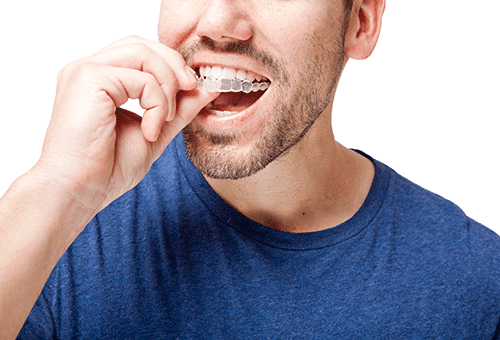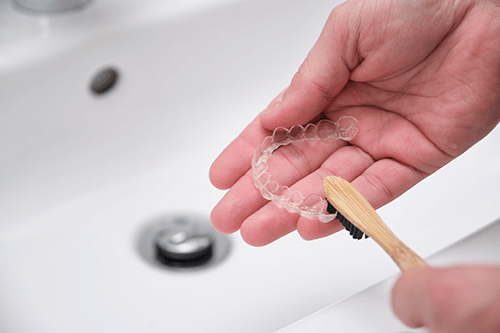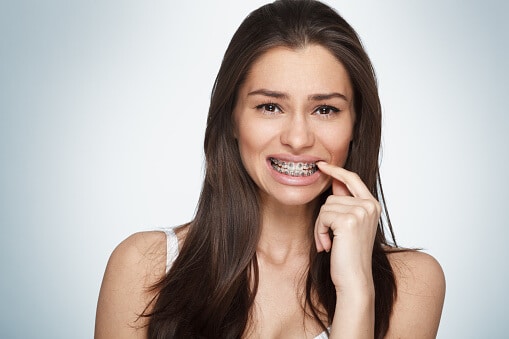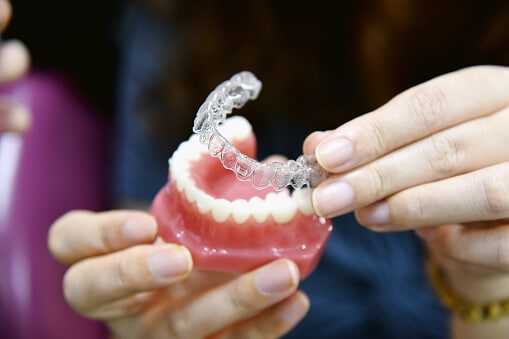Determine The Difference
Between Invisalign® & Braces
Depending on your needs, the right solution for you may be Invisalign or braces. We work with you to determine which solution will work best for your smile goals.
Pros Of Invisalign®
- Invisalign looks better cosmetically and is hardly noticeable to other people. There is a good chance that no one will even know you are wearing Invisalign aligners unless you tell them!
- No diet restrictions. Invisalign aligners are removed before you eat so you don’t have to change what or how you eat like you would with traditional braces.
- It’s easier to care for your smile. You can brush and floss your teeth as normal with nothing extra to worry about.
- Fewer consultations are required. Our Invisalign process can be started with just one virtual consultation. Braces require you to come into our office for multiple consultations before starting treatment.
Comfortable to wear. Invisalign aligners tend to be much less painful than traditional braces because they are made of a special plastic fitted to each patient’s mouth. Typically, patients have no cuts on the inside cheeks or salt washes to deal with.


Cons Of Invisalign®
- Patients need to take straightening their smile seriously. Being able to remove your aligners is a pro and a con. If you aren’t wearing your aligners at least 22 hours per day, you could risk spending money on a treatment that doesn’t end up working for your teeth.
Invisalign® Cost
A common con of Invisalign is also the cost. However, at The Airway Dentists, we consider our cost to be a pro. We offer Invisalign aligners for $3200, whereas most competitors offer it for $5000-$7000!
Pros Of Braces
- Braces are suitable for any treatment. No matter how simple or difficult your case is, braces will help straighten your teeth. Since braces use anchors and wire to pull teeth in place, they are the most powerful treatment method in moving teeth to the desired position.


Cons Of Braces
- Aesthetics of braces. Some people don’t like the look of braces and may feel self-conscious about their appearance.
- Taking care of your smile. Brushing and flossing your teeth is more difficult with traditional braces due to the wire. With braces, you risk plaque buildup around the braces which could lead to staining and decay.
- Regular in-office consultations. Braces require you to come into the office regularly so an orthodontist can check on progress and have them adjusted.
- Eating certain foods is not recommended. Hard and sticky foods should be avoided with braces because they can cause the arch wire to break. Multiple breakages can prolong your treatment time.
Invisalign® Vs Braces—What’s The Difference?
All in all, the right treatment method for you depends on your unique circumstances. Before we start any treatment, we will make sure to find the best solution for your smile. Ultimately, the decision is up to you, but the introduction of Invisalign® to the market introduced a more efficient, less painful way to straighten teeth.
Materials. Invisalign® uses clear, transparent aligners, while braces use wires and brackets.
Removability. Invisalign® aligners can be removed by the user at any time, while braces can only be removed by a professional.
Food Restrictions. Invisalign® allows a user to eat whatever they would like and not make changes to their oral care practices, while braces restrict what the user can safely eat and require special maintenance and care.
Injury Risks. Invisalign® aligners do not present any injury risks, while braces can lead to cuts and other injuries.
Visibility. Invisalign® aligners are nearly impossible for others to notice, while braces are almost impossible to miss.
Find Out If Invisalign® Is Right For You

